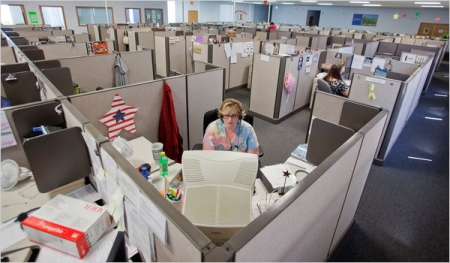March 29th, 2011 by Bryan Vartabedian, M.D. in Opinion
No Comments »

I frequently talk about the visibility of doctors in the online space. How can doctors make content, contribute to the broader dialog, and be more visible? Maybe I need to spend less time pushing the idea that every doctor needs to create. Most doctors, after all, just want to listen and watch. Maybe we need to be cultivating dedicated communicators.
There’s a role evolving where physicians are formally involved in the creation of content and the maintenance of dialog. Wendy Swanson at Seattle Children’s Hospital and Claire McCarthy at Boston Children’s Hospital come to mind as good examples. Both serve as models for how institutions can leverage the voice of an individual for a branded online identity while contributing to the common good. Both are evolving as conversation agents on social platforms and IRL. Call them medical conversation agents of new media. Read more »
*This blog post was originally published at 33 Charts*
August 1st, 2010 by Berci in Better Health Network, News, Research
No Comments »

 There’s a new profession in the Internet era, the so-called “Internet Content Reviewer.” These people check all of the submissions and uploads on huge social networking sites, review tens of thousands of pictures, and make sure only legal content is being uploaded to these communities.
There’s a new profession in the Internet era, the so-called “Internet Content Reviewer.” These people check all of the submissions and uploads on huge social networking sites, review tens of thousands of pictures, and make sure only legal content is being uploaded to these communities.
It seems a new mental health, “social” disease is starting to spread: Internet Moderitis. An excerpt from a New York Times piece on the topic:
Ricky Bess spends eight hours a day in front of a computer near Orlando, Fla., viewing some of the worst depravities harbored on the Internet. He has seen photographs of graphic gang killings, animal abuse and twisted forms of pornography. One recent sighting was a photo of two teenage boys gleefully pointing guns at another boy, who is crying.
YouTube, a division of Google, is an exception. If a user indicates a video is inappropriate, software scans the image looking for warning signs of clips that are breaking the site’s rules or the law. Flagged videos are then sent for manual review by YouTube-employed content moderators who, because of the nature of the work, are given only yearlong contracts and access to counseling services, according to Victoria Grand, a YouTube spokeswoman.
Photo credit: Stephen Mally for The New York Times
*This blog post was originally published at ScienceRoll*
July 1st, 2010 by Berci in Better Health Network, News, Opinion, Research
No Comments »

My good friends, Tom H Van De Belt and Lucien JLPG Engelen from the Radboud University Nijmegen Medical Centre, just published a great systematic review in the Journal of Medical Internet Research about the definitions of medicine 2.0 and health 2.0 It was time to collect all the available data about these terms. An excerpt from the abstract:
Objective: The objective was to identify unique definitions of Health 2.0/Medicine 2.0 and recurrent topics within the definitions.
Methods: A systematic literature review of electronic databases (PubMed, Scopus, CINAHL) and gray literature on the Internet using the search engines Google, Bing, and Yahoo was performed to find unique definitions of Health 2.0/Medicine 2.0.
Results: We found a total of 1937 articles, 533 in scientific databases and 1404 in the gray literature. We selected 46 unique definitions for further analysis and identified 7 main topics.
Conclusions: Health 2.0/Medicine 2.0 are still developing areas. Many articles concerning this subject were found, primarily on the Internet. However, there is still no general consensus regarding the definition of Health 2.0/Medicine 2.0.
*This blog post was originally published at ScienceRoll*
April 15th, 2010 by Berci in Better Health Network, Health Tips
1 Comment »

I recently come across BodyTrace, a nice way to combine a bathroom scale that wirelessly uploads and displays your weight and BMI and a website where you can track all the changes with visualized solutions. An excerpt from the description:
We are using the GSM network to transmit your weight to our website. We use these measurements to create weight and BMI charts and by combining this information with additional data that we collect (from food tracker, for example) we can better evaluate your progress and give you feedback on how to reach your goals.
They also have a collaboration with DailyBurn. You can read the whole story from the first idea on the blog.
See more examples of how Web 2.0 or social media can be used in fitness here.
*This blog post was originally published at ScienceRoll*
December 21st, 2009 by PhilBaumannRN in Better Health Network, Opinion
1 Comment »


- Image by pomarc via Flickr
When status quos collapse, for whatever reasons, are their replacements necessarily better? Does the demise of traditional media powers mean that new media powers will lead to more Democracy? Will cultivated professions which require years of training and mistakes and experience – such as Medicine – give way to amateurs who can succeed in creating appearances of Authenticity?
Last century, not everybody could publish their thoughts without expending some form of considerable energy. Now, with Twitter, anyone can tell the world what s/he thinks at virtually zero expense (save the time value of their tweets). This is no doubt a radical shift in communications and publishing and connecting.
It’s easy to call this democratizing. But is it? Read more »
*This blog post was originally published at phil baumann online*















